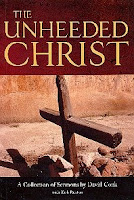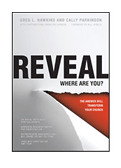Review: The Shack
 I’ve just finished reading William P. Young’s The Shack. I’m reading it because it seems to be flavour of the month in popular christendom at the moment – which says nothing about its value, but something about its influence.
I’ve just finished reading William P. Young’s The Shack. I’m reading it because it seems to be flavour of the month in popular christendom at the moment – which says nothing about its value, but something about its influence.
Respected Christian authors and commentators either love it (Eugene Peterson is quoted on the front cover “This book has the potential to do for our generation what John Bunyan’s Pilgrim’s Progress did for his. It’s that good!”) or hate it (Mark Driscoll decries its heresies on youtube). So what’s my take?
It’s a book that’s certainly well written. It evokes emotions and tells a story well. It is an allegory – or, perhaps more precisely, a narrative theology – as the main character, Mack, encounters personifications of a triune God. There are some gems in it, but in the end I would classify this book as dangerous.
It is an allegory – but an allegory of what? If the metaphor that Young spins is meant to be a word picture, a narrative that describes God-as-God-is then it is blatantly heretical. When God shows up at the end of the chapter 5 “he” shows up (in the midst of a straight-from-Narnia cliche of snow giving way to spring-time-flourishing grass) as three persons – “Papa” who is an African American woman meant to be God the Father (towards the end “she” does change and is portrayed as an older man as Mack grows through parent issues and comes to a place where he can handle that portrayal); Jesus who is a Jewish man (of course); and Sarayu a complex enigmatic hard-to-grasp woman who is meant to be the Holy Spirit.
If that’s the intended metaphor, it is not an accurate portrayal of trinitarian theology. For instance, Young runs straight into the error of modalism in which the diversity of the trinitry is reduced to being a number of “modes” of one being. And so Young’s “Papa,” as well as Jesus, bears the mark of the cross (an error known technically as patripassionism). All three persons appear as human (although Jesus is acknowledged to be “more so”), there is little explanation of the differences between the three persons and when a fourth “personification” in the form of a woman named Sophia (representing wisdom) comes along there is nothing but a throw-away sentence to indicate that she is any different to the three other persons. One of the inherent problems with modalism is that there is no need to have “three in one” but simply “multi-expressions-of-one” and the danger of portraying it the way Young does allows people to appeal to whatever image of God suits them (from an African-American woman who likes to cook, through to shimmering dancing spiritual gardener). Young mishandles the diversity of the Trinity.
Furthermore, it is dangerous ground to go beyond “God reveals himself as…” to “this is what God looks like…” It borders on presumption. Even though the divine persons in this narrative state that they are self-limiting themselves in order to interact with Mack, and therefore provide theological wriggle room for the author, Young also mishandles the unity of the Trinity.
Because in reality when you see see Jesus you see the Father, and the Spirit is the Spirit of Christ and the Spirit of the One who raised Christ from the dead. If you are going to put God into a story (and many have) then God can only have one face – the face of Christ. In God there is no unChristlikeness at all, as they say. If Young simply had Mack meet Jesus at the Shack then he would be on safer ground, because it’s through Christ that Mack (and we) can meet the Father by the Spirit. Never separated – such as when Mack talks to Papa while Jesus is off woodworking – but all life emanating by the Father in the Son reaching forward as empowering Spirit.
So Young mishandles the Trinity. It may seem like I’m being a theological pedant – nitpicking. But there are very good reasons as to why precision in this area is necessary. If you get this wrong, and walk along the erroneous road, you end up not with gospel and life, but death. If Jesus does not reveal the fullness of God then Jesus is not “God with us” and we are stuck in our sins and griefs and God has just pretended. If we come to the Jesus of this book we keep looking behind him to find the nice pretty dancing Spirit-girl or the homely Papa-woman, he is not enough for us. Ironically, even though Mack is constantly surprised and challenged by “God” in the narrative, this book gives permission for us to demand that God appear to us in times of need the way we think we need him to be (“submitted to” us and “self-limited” and thus conforming to us in some way) rather than as he is and as he came to us.
There are some “gems” and snippets that are intriguing and perhaps helpful. Some of the issues of theodicy (how can a just God be both all-powerful and good in an evil world) are dealt with well. But the problems are difficult to wade past. The Lordship of Christ is underplayed as is a sense of God’s justice and judgement. The metaphor, like all metaphors, extends into error and the boundaries are not strong enough to prevent the unwary from going there. It is a dangerous book.
If there is value, if we are to be generous, then we could state that Young is not spinning an allegory of God-as-God-is but a narrative describing the healing of someone from a painful loss. If the back cover is to believed – “William P. Young… suffered great loss as a child and young adult…” – then we are simply seeing a presentation, maybe, of Young’s own experience of healing and forgiveness. So perhaps the best way to read it is as an allegorised biography rather than an allegorised theology. There is some joy in seeing this story as something akin to a grown-up story about Wemmicks (a metaphorical world for children from Max Lucado – that, by the way, is not also without its dangers).
But in the end – it seems people are taking this book as theology. And they are building their spirituality around this book. That may not have been Young’s intention – but it makes this book dangerous nonetheless.
Eventually, when it comes to assessing these sorts of novels I have to ask the question “Having read it, have I been encouraged to seek God for myself in his Word by his Spirit.” And the answer for this book is “No.” There is little reference to the Bible in the narrative and when it is included it is as an illustration about (wrong) “preconceived ideas” not as words of life. Where then do I turn after reading this book?
Sadly, the message is this – “We invite you to continue your experience with The Shack at our website, theshackbook.com” – where it’s not about being encouraged to turn to God or the local church or come to Jesus in some way but rather simply to “share how you feel,” “share your insights,” “communicate with the author” and “purchase additional copies.” And of course you can contribute to “The Missy Project” to help spread this
book (not the Bible, or the gospel) further and wider and fund a possible movie version.
And so popular christendom gets caught up into another merchandising extravaganza and looks to the pantheon of WWJD and “The Prayer of Jabez” which now includes “The Shack.” Invest in other pursuits rather than this book.












